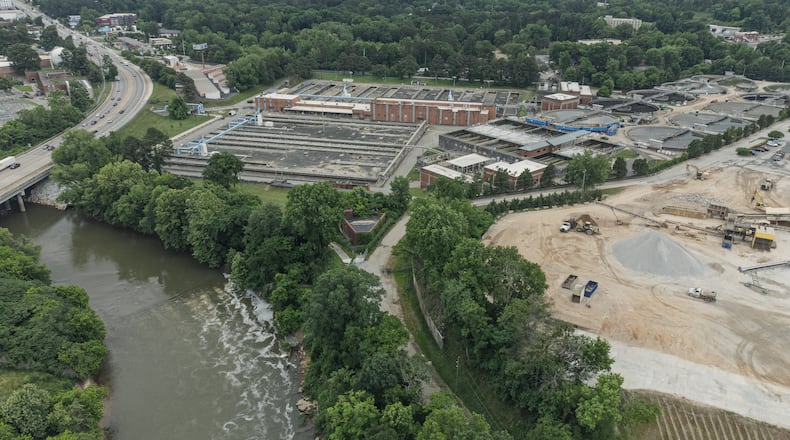If Atlantans were not thinking about their source of drinking water before this summer’s water crisis, they are now. The failure of multiple water pipes was a harsh reminder that water infrastructure and the decisions to keep it functioning affect our everyday lives. And it’s not just the drinking water that comes into our homes — the wastewater that goes down the drain and into the sewer system needs our full attention right now, too.
When someone flushes a toilet in Atlanta, chances are the wastewater goes to the R.M. Clayton Water Reclamation Center. It is one of three wastewater treatment plants serving the city, and the largest in Georgia. Right now, it is discharging improperly treated wastewater, including human waste, into the Chattahoochee River, posing a direct threat to the river and downstream communities. This is why, on July 2, Chattahoochee Riverkeeper notified Atlanta that it would have 60 days to stop discharging illegal levels of pollution from the R.M. Clayton Plant into the river or we would file a lawsuit in federal court for Clean Water Act violations.
Credit: Handout
Credit: Handout
In March 2024, Chattahoochee Riverkeeper (CRK), a nonprofit environmental organization that monitors water quality throughout the Chattahoochee River Basin, detected dangerously elevated levels of E. coli bacteria in the Chattahoochee River and traced the source to the R.M. Clayton plant’s outfall into the river. Daily testing conducted by CRK at the outfall found E. coli levels were on average 340 times higher than the amount recommended by the U.S. Environmental Protection Agency for safe water recreation.
Chattahoochee Riverkeeper sounded the alarm to the public because no one else stepped up — not the Atlanta Department of Watershed Management nor the state nor any other environmental agency.
After news spread of unsafe conditions in the river, Atlanta attributed the plant’s failure to heavy rainfall and multiple discharges of illicit substances to the plant. But an inspection conducted by Georgia Environmental Protection Division (EPD) revealed problems at all stages of water treatment, indicating deliberate decisions to defer maintenance.
Ongoing monitoring by CRK at the plant’s outfall has revealed sporadic spikes in E. coli levels as recently as June 6. Exposure to E. coli bacteria can cause serious illness, especially in young children, the elderly and the immunocompromised. And along with bacteria, there are serious concerns about the high levels of organic material and nutrients entering the river from the plant’s discharge, which violate the plant’s permit. The contaminants, including ammonia and phosphorus, contribute to low oxygen levels in the river, which are detrimental to aquatic life.
The loss of drinking water and ongoing problems at the plant are not “acts of god.” They are critical infrastructure failures that demonstrate a continued lack of leadership and transparency among city officials, reminiscent of the city’s neglect in the 1990s — neglect that spurred the founding of Chattahoochee Riverkeeper in 1994.
Our organization’s first legal effort involved Atlanta’s infrastructure. For decades, decisionmakers decided not to expand and improve the city’s water infrastructure even as the region grew explosively in the 1970s. CRK’s monitoring showed that the city’s antiquated sewer system was polluting the river and harming ecosystems and communities downstream.
CRK took legal action against the city and prevailed in the courtroom. Under the leadership of then-Mayor Shirley Franklin, the city decided to prioritize a comprehensive plan to reduce polluting sewer and stormwater overflows into the river and its tributaries. The plan, known as Clean Water Atlanta, not only tackled sewer and wastewater infrastructure, but it also launched projects to improve the drinking water system.
To pay for the necessary water infrastructure, customers accepted higher water and sewer rates. Additionally, Atlanta voters approved the first Municipal Local Option Sales Tax (MOST) in 2004, which has been reapproved six times, including in May. The financial tool has reportedly generated $1.8 billion in revenue. And on June 3, the city’s chief financial officer told the council members the Department of Watershed Management’s financial resources are “plentiful.”
All of this leaves us with questions.
If the Department of Watershed Management has a strong balance sheet, why has the drinking water system failed multiple times over the past few years?
Even more troubling, given the availability of funds, why has the R.M. Clayton plant suffered ongoing operational failure?
Infrastructure is often out of sight and can fail without warning. But the city’s water and sewer failures are symptoms of systemwide problems and conscious decisions not to prioritize critical infrastructure. These decisions have consequences for residents and businesses — and for the river they depend on.
Atlanta and the region are expected to keep growing. The effects of climate change — like the “rain bomb” that generated flooding on Atlanta’s Westside in the fall of 2023 — are also real and pose a threat to the city’s infrastructure.
The drinking water and sewer systems run through different pipes, but they are maintained by the same department. We urge the city to address both issues together and stop ongoing pollution violations at the R.M. Clayton wastewater treatment plant. Thankfully, we identified this problem before an ecological catastrophe occurred, rather than after, but time is now running short. If the discharge of improperly treated wastewater, including human waste, continues into the Chattahoochee River, all the progress we have made over the past 30 years could be reversed.
Jason Ulseth is the executive director and riverkeeper of Chattahoochee Riverkeeper.
About the Author
Keep Reading
The Latest
Featured


